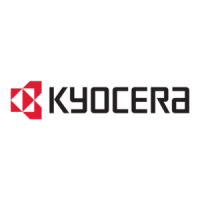) C-1 C.1. Parallel Interface Interface Signals The pins of the parallel interface connector carry the signals listed in Table C.1. Asterisks in the table indicate
signals that are active low.
The table also indicates whether each signal is incoming or outgoing with respect to the printer. Table C.1. Parallel Connector Pin Assignments Pin 1 2 3 4 5
6 7 8 9 10 11 12 13 14 15 16 17 18 19 20 21 22 23 24 25 26 27 28 29 30 31 32 33 34 35 36 [ In/out In In In In In In In In In Out Out Out Out In -- -- -- -- -- --
-- -- -- -- -- -- -- -- -- -- In Out -- -- Out In Description Strobe* [nStrobe] Data 0 [Data 1] Data 1 [Data 2] Data 2 [Data 3] Data 3 [Data 4] Data 4 [Data 5]
Data 5 [Data 6] Data 6 [Data 7] Data 7 [Data 8] Acknowledge* [nAck] Busy [Busy] Paper Empty [PError] On-Line (Select) [Select] Ignored [nAutoFd]
Not connected 0V DC Chassis GND +5V DC Ground return Ground return Ground return Ground return Ground return Ground return Ground return
Ground return Ground return Ground return Ground return Ground return Reset [nInit] Error*, returns error status if FRPO O2=2 [nFault] -- Not
connected Power Ready Select In [NSelectIn] ]: Signal names in the Nibble (high) mode (IEEE 1284). In the Nibble (high) mode, these signals are bi-
directional.
C-2 C.1. Parallel Interface Detailed descriptions of the signals follow. Strobe* [nStrobe] (Pin 1) A negative-going Strobe* pulse causes the printer to read
and latch the data on the Data 0 [1] to Data 7 [8] signal lines. Data 0 [1] to Data 7 [8] (Pins 2 to 9) These eight signals form the data byte sent from the host
computer to the printer.
Data 7 [8] is the most significant bit. Acknowledge* [nAck] (Pin 10) This negative-going pulse acknowledges the previous character received by the printer.
Acknowledge* pulses are sent only when Busy is low. Busy [Busy] (Pin 11) This signal is high when the printer is busy and low when it is able to accept more
data. Every high-to-low transition is followed by an Acknowledge* pulse. Paper Empty [PError] (Pin 12) This signal goes high when the printer runs out of
paper. On-Line [Select] (Pin 13) This signal is high when the printer is on-line and low when the printer is off-line. It goes low when the upper unit is raised,
or when the ON LINE key is pressed to set the printer off-line. The Paper Empty and On-Line signals are not used unless enabled by the FRPO command (O2
parameter). +5V DC (pin 18) This line is connected to the printer's +5V DC line (+5V ±0.
5V, 250 mA [Serial and Parallel total] maximum, fused.) Reset [nInit] (Pin 31) This signal is used in the standard Centronics interface to enable the computer
to reset the printer. Error* [nFault] (Pin 32) When the high-speed parallel line control is on (FRPO O2=2), this line returns error status. Auxiliary output 1
(Pin 33) This signal line is not used. Power Ready (Pin 35) This signal is high when the printer's power is on. Select In [NSelectIn] (Pin 36) This signal is
used in some versions of the Centronics interface to enable the computer to force the printer on-line. In high-speed mode, it is used as an interrupt. C-3 C.2.
RS-232C/RS-422A Interface C.
2. RS-232C/RS-422A Interface RS-232C interface Interface Signals The pins of the printer's RS-232C interface connector carry the signals listed in Table
C.2. The table also indicates whether each signal is incoming or outgoing with respect to the printer. Table C.
2. RS-232C Signal Pin Assignments Pin 1 2 3 4 5 6 7 20 In/out Out In Out In In Out Signal FG TXD RXD RTS CTS DSR SG DTR Description Frame ground
Transmit Data Receive Data Request To Send Clear To Send Data Set Ready Signal Ground Data Terminal Ready Brief descriptions of the signals follow. FG
- Frame Ground - (Pin 1) This pin is connected directly to the printer frame. TXD - Transmit Data - (Pin 2) This output carries asynchronous data sent by the
printer to the computer. It is used mainly in handshaking protocols.
RXD - Receive Data - (Pin 3) This input carries serial asynchronous data sent by the computer to the printer.
You're reading an excerpt. Click here to read official KYOCERA
FS-1750 user guide
http://somemanuals.com/dref/324820

